Returning recently from a weekend stay with friends, the car loaded with vegetables and fruit from their garden, I was reminded of the customary exchanges of home grown produce in Coorg.
When one sets out to visit someone in Coorg, chances are that the back of the vehicle will be laden with a sampler of whatever is currently yielding on the land, garden or kitchen garden. Avocados, a big bunch of mara balé (a local variety of banana), or an even bigger jackfruit. On the way home, one will very likely have been gifted, in exchange, some chikoos (sapotas), lychees, maybe some unusually succulent broad beans.
And there are the customary exchanges that accompany the exchanges along the lines of:
“You must try these. I got the plants from Kuttappa last year and they’re fruiting like nobody’s business. Fantastic flavour and such small seeds!”
“We saved the seeds from the fruit Kalu sent us but they didn’t germinate, so he’s promised to send us some cuttings.”
“I looked up the mystery fruit and it’s a Lakoocha.”
“These are limes from the plants Jagan brought from Bangalore a few years ago.”
The conversation typically meanders in circles of sources, ideal growing conditions, and promises of more exchanges.
Not long ago in Coorg, I visited the home of an elderly gentleman who had known my grandparents. We took along bunches of ripe bananas and homemade jam for his grandchildren. After chatting over cups of hot, milky coffee and more thindi (snacks) than were good for us, we made our way out to the yard and began to say our goodbyes. The gentleman disappeared into the back of the house and we heard a flutter from the chicken coop. He emerged a few minutes later with three freshly laid eggs and an apology for his chickens being somewhat uncooperative of late. We were asked to wait just a little longer and, from the corner of my eye, I saw the sprightly daughter-in-law of the house racing down the path to the pumpkin patch and returning with a prize specimen balanced on one palm – a plump bunch of bananas rounded out their generosity.
Then there are visitors from the village who stop by for a chat and a cup of coffee, bringing wild honey, a bundle of edible ferns, a bottle of fresh toddy, or freshly picked pavakké (Momordica dioica) tender and green. These guests also carry the slow, gentle pace of rural life with them.
Here in Canada, I’m surprised by a neighbour with an enormous bunch of Tulsi, grown in his garden.
“Holy Basil, it’s Indian, isn’t it?” he says, handing the fragrant bundle to me.
I give him Tulsi tea and a list of the virtues of tulsi. He gives me a tulsi plant. I give him fresh turmeric pickle and a recipe and receive in return a trio of zucchini, the largest one clocking in at 2kg! And so it goes on.
From the latest harvest, freshly picked as we said our goodbyes on the weekend, the perfect little ears of corn, hardly six inches long have been boiled and eaten. Tomatoes have met the giant zucchini over a meal or two .The great pumpkin is ripening quietly in a cool corner of the deck.
Of course everything tastes good, but it’s the personal exchanges that really tip the scales. Where there are gifts from the earth, there’s always time to talk!
Pavakké
One of the things my mother gets all excited about (somewhat disproportionately, I used to think! ) is pavakké, or spiky gourd. Her mother made a mutton curry with wedges of this gourd, cooked along with the meat. I have eaten a version of this and it is delicious.
There was another dish that my grandmother made, a light stew of pavakké, cooked in milk, the memory of which would send my mother into raptures. I had never tasted that. I’m pretty sure it’s not a Kodava dish, but I’m not sure where my grandmother came upon this recipe. Nevertheless, I have always been curious about it. Some years ago, I chanced upon a recipe for “bottle gourd in milk” in Malini Bisen’s wonderful book “Vegetable Delights”*.
It sounded familiar. I cooked up a batch using some tender pavakké in lieu of the bottle gourd and voila – my mother declared it to be a close approximation of what her mother made! Allowing for the fact that we no longer have, as my grandmother did, ready access to creamy fresh milk from the cows grazing in a field behind the house and tethered a short hop from the kitchen door, that’s good enough for me.
So, based on Malini Bisen’s recipe, here is
Pavakké cooked in milk
- 1/2 kilo tender pavakké, sliced into quarters
There is a mild hint of bitterness to the gourd (it is related to bitter gourd). If that doesn’t appeal, you may want to blanch it briefly before you proceed .This recipe works well with snake gourd, ridge gourd, zucchini, and of course, bottle gourd.
- 1 cassia leaf
- 1″ stick cinnamon/cassia
- 10 or more black peppercorns
- 2 – 3 cloves
- 2 – 3 dry red chillis (I like bedgi chillis for this)
- 1 tbsp ghee
- 1 – 2 cups whole milk
- Salt to taste
Heat the ghee in a pan and put in the cassia leaf, followed by the cinnamon stick, cloves, peppercorns and red chillis, in that order. Fry for a couple of minutes, allowing the chillis to colour the oil but not darken too much.
Add the pavakké, stir to mix , and cook for a couple of minutes. Add salt, cover and cook until half done. Then add the milk and simmer very gently until done.
So delicious, make more than you think you’ll need! This also makes a wonderful winter soup.
*Wilco Publishing House, ISBN 81-87288-14-0

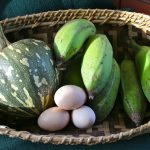
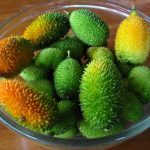
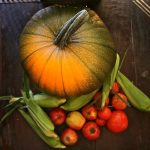
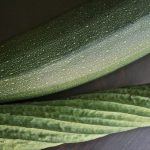
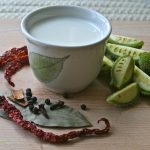
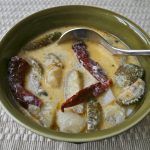
All the posts have brilliant pictures!!!
Thank you, Vallari! 🙂
Has Jr. managed to take a look yet?!